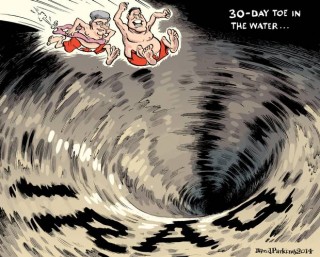Paul Koring provides a summary history of NATO (the North Atlantic Treaty Organization) and issues related to the current Ukraine crisis.
Background material:
As hostilities between Russia and Ukraine escalated, NATO allies met to determine their appropriate response to the crisis. Ukraine is not a member of NATO, but it is the largest country in Europe, most of which includes NATO members. In recent years internal tensions in Ukraine have escalated between those—mostly in West Ukraine—who wish to strengthen Ukraine’s connections to Europe and those—mostly in East Ukraine—who prefer stronger connections with Russia. Ukrainian presidents have been from both camps but, most recently, when the pro-Russian president of Ukraine abandoned his office and fled to Russia, a pro-Europe president was promptly elected in his place. Russian president Vladimir Putin objected to this process and quickly moved to “protect” pro-Russia Ukrainians by invading and occupying the Crimean peninsula. More recently, NATO reports Russian troops and weapons have been moved into East Ukraine in support of pro-Russian rebels who are fighting against the current Ukrainian government with the hope of achieving some form of East Ukraine independence.
NATO represents the largest treaty of nations on earth and therefore stands as a formidable potential opponent to Russian incursion in Ukraine. To date NATO has announced air patrols and reconnaissance activities, with Canada supplying several fighter jets for this purpose. The NATO summit was watched closely as the potential for a clash between NATO and Russia loomed larger.
Students can benefit from a short lesson on NATO, its formation, past military campaigns and its potential role in the current crisis.
Appropriate Subject Area(s):
Social studies, history, current events
Key Questions to Explore:
What is NATO and why is it increasingly important relative to the crisis in Ukraine?
New Terminology:
NATO, strategic, summit, counter-insurgency, expeditionary, ISIS, reinvigorated
Materials Needed:
Globe article, the Internet.
Introduction to lesson and task:
Using group discussion, the Globe article, and the NATO website, students will develop positions on the role of NATO in the Ukraine crisis.
Action (lesson plan and task):
Engage students in a short (five minute) discussion about NATO. Ask:
- There are many kinds of alliances among countries in the world. What is the largest of these? (NATO)
- Is Canada a member? (Yes, a founding member)
- What is the purpose of NATO? (To protect its members from aggression by other countries, especially, during the Cold War, The Soviet Union)
- Why is NATO in the news these days? (It is being called on to protect Ukraine from Russian military incursions into its territory)
Next, using a data projector and Internet connection, go to the NATO website: http://www.nato.int and click on “What is NATO?” under the heading “Organization.”
Scroll through the pages, pausing to highlight the member countries, mission statements and activities, but reserve your time for page four “Key Events.” Starting with 1949 select each of the key events and show videos or pictures for each. Encourage questions and discussion.
The NATO Wales summit will have been completed when you receive this lesson. Find any video or text that outlines the outcomes of the summit and spend a few minutes on reading/viewing and explaining the content you find.
Next, present students with the following writing assignment. They are to use the NATO website and the article by Paul Koring to inform a short essay on NATO, entitled Why NATO should/should not intervene in the Russia/Ukraine crisis. They need not take one or the other position, provided they provide evidence both for and against intervention. Their essay should include:
- References to NATO’s mission statements;
- Comparisons of previous NATO engagements (e.g., Afghanistan) with the current Ukraine crisis;
- An explanation of Article 5 and its relevance or not, to the current crisis;
- How a possible “arctic Klondike” might affect Canada’s role as a NATO member;
- A description of the role of a Rapid Reaction Force and how it might be deployed in Ukraine;
- How unconventional warfare presents a challenge to NATO;
- Why NATO is stepping up combat air patrols in Latvia, Estonia and Lithuania;
- Why they think Paul Koring suggests that Vladimir Putin has “reinvigorated” NATO;
- A summary conclusion in which you provide reasons that NATO should and should not intervene in the Ukraine/Russia conflict.
Consolidation of Learning:
Class discussion, preparing and submitting the written report.
Success Criteria:
Successful completion of the written report; constructive and relevant discussion.
Confirming Activity:
Evaluation of students’ completed reports.

